You might be wondering, is Gypcrete the same as concrete? But how are they similar? Are they the same thing?
Gypcrete and concrete are materials that are gaining momentum in the construction field. This is because they are both strong and durable. However, while they have some similarities, there are some differences too.
To answer these questions, we’ll look at a few features, benefits, and drawbacks to see how they differ.
Gypcrete is a floor underlayment material that combines gypsum and concrete. Meanwhile, concrete is a substance that has the qualities of stone-like mass. In terms of cost-effectiveness and durability, concrete is superior to other materials. Yet, for a thinner, more manageable material, gypcrete is an option. In the end, both are essential for various construction applications.
What is Gypcrete?
Gypcrete is an underlayment for floors consisting of gypsum and concrete.
You can see them on commercial & residential buildings to level and construct substrates.
A gypcrete is often put on top of a base made of metal or wood. This is to provide a flat floor suitable for installing tiles or other materials. Professionals apply thicknesses ranging from 1-4 inches.
Many people use gypcrete as a flooring material because it is long-lasting. In addition, gypcrete has an exceptionally smooth surface. Therefore, it can create a pleasing and modern atmosphere in any interior space.
Advantages And Disadvantages Of Gypcrete
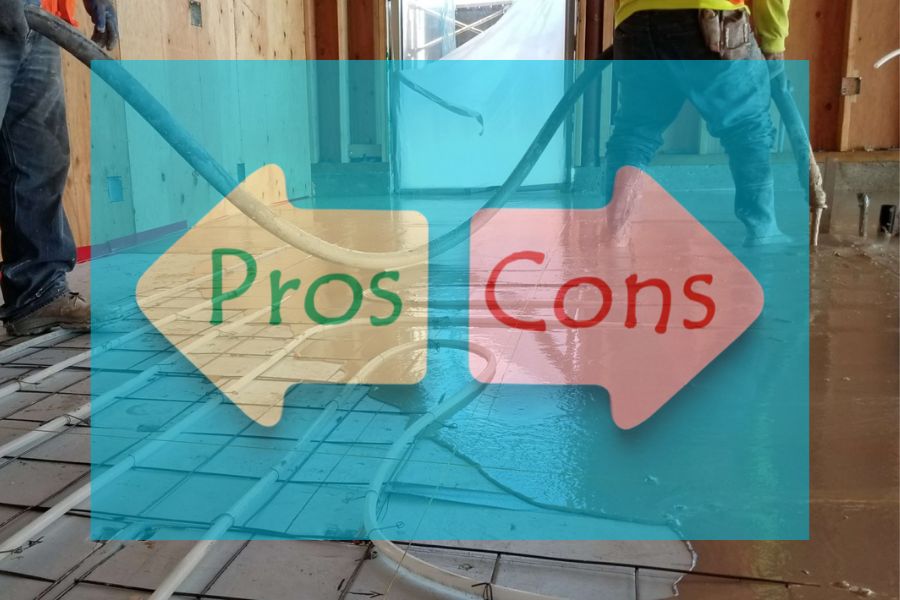
Advantages
- Ideal material for plant growth substrate since it can retain a lot of water and allows air to circulate.
- Combination of long-term reliability.
- Provide a wide range of aesthetic features.
- It can offer the benefit of soundproofing, making the environment cozier.
- Designed to facilitate a simple and speedy installation.
Disadvantages
- It is not as strong as its concrete cousin; hence it cannot support as much weight.
- Susceptible to cracking throughout its lifetime.
- Licensed professionals are necessary to make repairs to broken items.
- Not appropriate for do-it-yourself projects.
- An examination is essential once the gypsum underlayment is visible.
What Is The Common Purpose Of Gypcrete?
Insulation and soundproofing are two of the most typical applications for gypcrete.
Historically, it was common practice to construct radiant heat flooring using concrete.
Currently, this material has a wide variety of applications. Professionals can apply it in both wood-frame and concrete construction. Some of these applications include floor leveling and radiant heating. At the same time, it is also used in noise reduction and better fire ratings.
Architects and designers always favor Gypcrete. They often use it for the construction of high-rise structures.
Overall, gypcrete is a material that is frequently utilized as a sub-floor alternative.
What is Concrete?
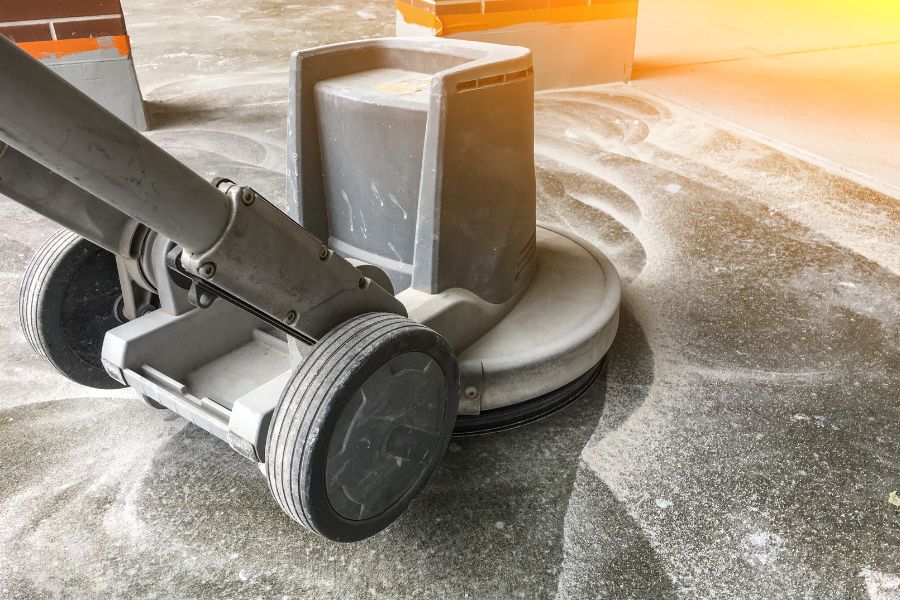
Concrete is a composite material produced to create an artificial stone-like mass.
It consists of cement or lime; aggregates might include sand, gravel, stone, and water. So it’s more than a mixture of aggregates, likes, gravel, and crushed rock.
As you can see, concrete is an essential and valuable building material.
It is versatile and can transform into a wide variety of forms. In addition, concrete is highly durable and requires little skill to produce. Aside from that, it’s cheap, easy to make, and quick.
It’s made to facilitate rapid building without sacrificing quality or dependability.
Advantages And Disadvantages Of Concrete
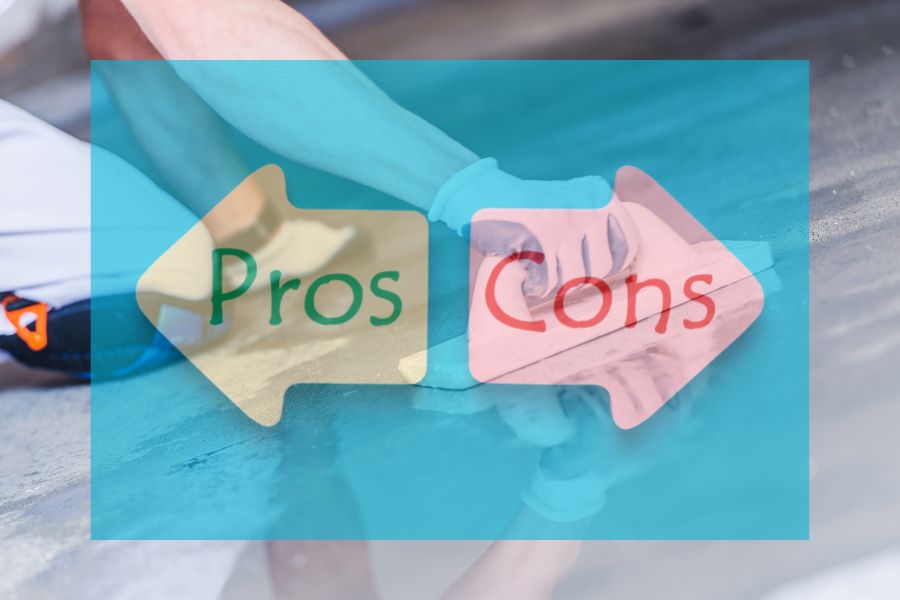
Advantages
- Materials needed to make concrete are almost anywhere.
- In contrast to natural stones, concrete does not have any flaws.
- It creates a fireproof structure since it does not burn.
- Concrete molds at the construction site save money.
- Protection against the elements. Ideal for use in underground bunkers during severe weather.
Disadvantages
- Concrete has a comparatively weak tensile strength compared to other options.
- It doesn’t bend or stretch as quickly as other materials.
- Concrete is relatively heavy for how strong it is.
- To some extent, soluble salts may be present in concrete.
- Crumbling occurs in constructions under prolonged stresses.
Common Uses Of Concrete
As a result of its adaptability, concrete provides a wide range of applications.
Concrete is frequently used as a foundational material in the building industry. At the same time, builders use it to fabricate a wide range of precast goods.
Some of the applications are:
- Building materials
- Roads and highways
- Bridges
- Bollards
- Dams
Most modern residential and commercial construction utilizes concrete. Driveways and columns are among the many commonplace places.
Generally, insulating concrete can save heating and cooling costs by more than 40%. Concrete achieves this by trapping heat within the wall.
Is Gypcrete The Same As Concrete?
Several homeowners and builders consider gypcrete a cousin of concrete.
This is because of how similar the two materials are.
Generally, they share a cement base foundation and a lengthy curing time. At the same time, they possess similar compressive strength. Additionally, they are fragile to freeze-thaw cracking.
On the other hand, it is not the same in terms of utility, weight, versatility, or longevity. This will include a lot of factors which we will discuss furthermore.
Overall, they serve to provide long-lasting insulations for residential and commercial properties.
What Are the Differences Between Gypcrete And Concrete?
As we’ve seen, gypcrete and concrete are materials with a wide range of applications.
Now that we know what gypcrete is let’s find out how it compares to concrete and what sets it apart.
1. Water Resistance

Despite its name, gypcrete is not made entirely of gypsum. But instead, it is a cement that contains the substance of gypsum ingredients. However, gypsum does not have high water resistance.
Therefore, you shouldn’t put gypcrete anywhere it will get wet. Additionally, it would be best if you did not expose it to water elements for long periods.
On the other hand, concrete is naturally resistant to water. This makes it an excellent choice for underground spaces. At the same time, it is great for overwater constructions like bridges and basements. Airport runways and sand pool decks could all benefit from its high absorption rate.
Compared to gypcrete flooring, concrete topping is preferable in wet environments.
2. Density And Strength

The typical weight of gypcrete is seven pounds per sqft for a pour of a standard 34″ thickness. A mix of gypcrete raises the compressive strength of the final concrete product.
Meanwhile, the standard density of concrete is 150 lb/ft3. This translates to a one-foot-wide block. Moreover, the power of concrete is on display in the Enguri Dam, the world’s second-highest arch dam.
As you can see, the aggregate materials in concrete provide exceptional resistance. So it is safe to say that they are resistant to compressive pressures. And unlike gypcrete, it won’t crack while you nail down your new floor.
3. Ease Of Installation Process
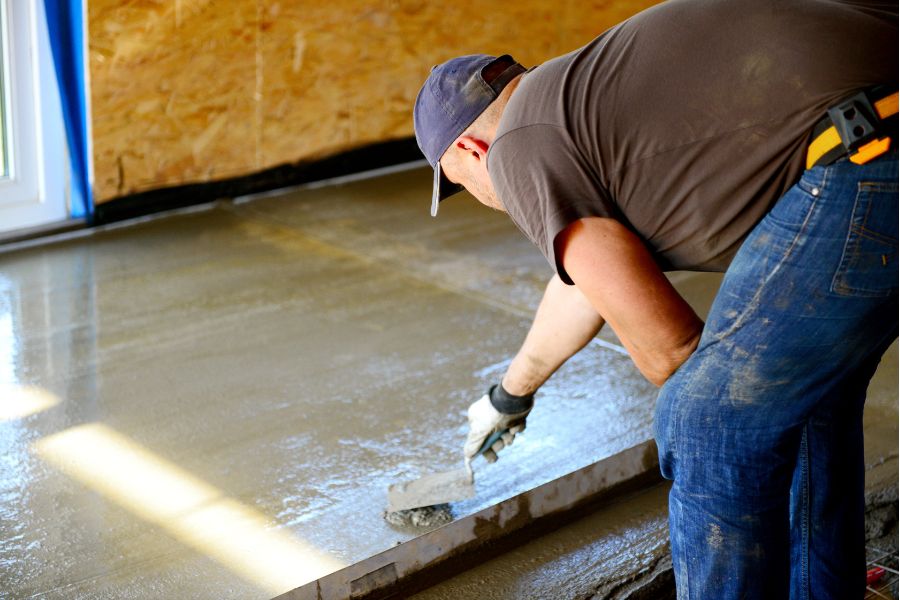
For a proper gypcrete installation, it is advisable to hire a skilled contractor. It’s possible to overmix if you try to do this on your own. Improper mixing can lead to trapped air and pinholing in the applied material.
However, a nice concrete driveway is something you can construct on your own. But you need to plan and prepare thoroughly. Remember to work for a small portion to maximize the ease of concrete installation.
Generally, concrete doesn’t need complex machinery or specialization to install. This is because of its abundant availability and simple mixing. Meanwhile, mixing gypcrete needs hiring a pro to install one.
4. Sound Insulation
Gypcrete has gypsum materials that have the density to decrease sound waves. In addition, it can moderate the vibrations of higher-frequency sound waves. Simply said, gypcrete materials dampen sound on both extremes of the frequency range.
However, concrete falls short when it comes to noise reduction. While concrete is an excellent material, it is not favored by homeowners regarding soundproofing. Contrary to popular belief, concrete’s thickness doesn’t make it a soundproofing barrier.
Therefore, homeowners value gypcrete’s soundproofing capabilities above those of concrete. Soundproofing is an essential feature of several building systems. And the gypcrete mix provides better soundproofing than other materials.
5. Cost
Average gypcrete prices vary from $3 to $5 per square foot. For specialized gypcrete, it can cost about $8 per sqft.
Regarding concrete costs, use a rate of $137 per yard as a rough estimate. If you need a simple concrete slab poured, you may expect to pay between $4.65 and $6.85 per square foot.
Keep in mind
Factors will include contractor prices, labor rates, and material costs. It can also depend on application time and gypcrete/concrete types.
Concrete is a cheaper choice because of its low material and labor costs. Another factor is that you can source it anywhere quickly. Moreover, an additional $2 to $4 per sqft is the price to consider when using gypcrete.
6. Weight
Gypcrete weighs only about 13 lbs, making it a lightweight material. However, due to its low strength and fragility, it is not meant to support the weight of people walking on it.
Meanwhile, concrete has a density of 4,050 pounds per cubic yard when you pour it into a slab. The thickness of shattered concrete is 2,025 pounds per cubic yard. Several structural jobs benefit from the use of high-performance and heavy concretes.
In light of this, the weight is the primary distinction between concrete and gypcrete. Since it is lighter and easier to work with, gypcrete is a great underlayment.
7. Fire Resistance
Gypcrete is an excellent underlayment because of its high fire rating from UL.
Because gypsum is a fire-resistant material, the floor is safe in the event of a fire. In addition, as the water vaporizes in response to the flame’s heat, it acts as a retardant to the fire’s progress.
Meanwhile, for structures, nothing beats the fireproof qualities of concrete. It is noncombustible. It is well-documented that concrete has high fire resistance. And in most contexts, practically fireproof.
Above all, gypcrete and concrete can both withstand fire. This is because of their smooth and fireproof surfaces.
8. Environmental Impact
Due to its composition of post-consumer waste, gypcrete is a good material for the planet. In addition, it’s low upkeep because you don’t need to polish it.
At the same time, demolishers recycle concrete as gravel and landscaping stones. It transforms into mulch after the demolition of an old concrete structure. The purpose of recycling concrete is to reduce the amount of waste sent to landfills. And to save power throughout the processing stages.
Generally, gypcrete and concrete materials will have fewer adverse environmental effects. By passing through a crusher, demolished properties can benefit from recycling.
9. Aesthetics And Finishing Options
The aesthetic qualities of gypcrete make it a popular flooring material. Gypcrete finishing provides a fresh and modern appeal. This time-tested material is enjoying a spike in popularity.
On the contrary, concrete comes in various shapes, colors, and textures. This is to meet the aesthetic and practical needs of contemporary building design. The most long-lasting concrete coating is epoxy. Homeowners usually pour into cracks and crevices to smooth the surface out.
Above all, homeowners apply gypcrete using a float, and they often trowel it to get a flat surface. Meanwhile, smooth concrete requires a few finishing processes: screeding, edging, and floating.
Therefore, gypcrete has more straightforward finishing options than concrete.
Gypcrete Vs. Concrete – Which Is Best?
When it comes down to it, both gypcrete and concrete offer excellent benefits that the other does not, each material has its place in the construction industry.
As you can see, there are strengths and weaknesses with both materials.
Concrete is the better choice if you want the best strength at the lowest price. And if you are seeking a more traditional look. However, if you want a thinner material that is easier to work with, then gypcrete is for you.
Concrete is the more traditional choice, with a long history of use. At the same time, gypcrete shows excellent potential to make modern products even better.
Concrete is likely still the leading and best future construction choice.
FAQ
How Thick Can Gypcrete Be Poured?
You can pour gypcrete levelers to a depth of 76 mm (3 in. ). At the same time, you can pour 25 mm (1 in. ) for conventional cement levelers.
Gypsum levelers produce an STC and IIC class when used with sound mats. It exceeds the standards of Section 1207, IB Code for sound transmission & insulation.
Over wood subfloors, the minimum thickness varies according to the flooring system. Gyp-Crete over 34″ (19 mm) tongue-and-groove is the reliable choice for covering a wood frame.
When applied on concrete, gypcrete is typically at least half an inch thick” (13 mm). You can also feather edge the 1.4 mix design.
Is Gypcrete Cheaper Than Concrete?
No, gypcrete is not cheaper than concrete. It’s more costly.
As mentioned earlier, the low cost of materials and labor makes concrete a cheaper option. Compared to gypcrete, the cost of concrete is around half as much. And because there are few suppliers, the market price of gypcrete is more excellent.
However, to cover smaller areas, gypcrete is more cost-effective. It is a cheaper method than building a new concrete slab.
In some cases, gypcrete may be less expensive than concrete. Yet it will depend on the ingredients.
Can Gypcrete Be a Finished Floor?
Yes. Polishable ultra-armor is one of gypcrete’s features for creating a finished floor.
It’s ideal for use as a subfloor because of its smoothness and fire resistance.
Staining gypcrete and using it as finished flooring is a growing trend. Concrete floors with a variety of colors are all the rage these days. You can also apply Skraffino products to stain a concrete floor.
However, in most cases, it is necessary to fix the gypcrete to make it level. This is because even at the edges, the pour is not uniform.
Within a day, you may cover 20,000 sqft of floor space. And within 48 hours, you can begin putting the final touches on the floor.
Does Gypcrete Need To Be Sealed?
No, you don’t need to seal gypcrete if you use it as a base for floating floors.
This means there is no volatile organic compound (VOC) off-gassing. However, if you want to walk on the gypcrete before installing flooring, you should do so with caution.
Most gypcrete systems do not need any further sealing because they are self-contained.
Therefore, it can reduce the hardwood flooring installation times. You can achieve this by skipping the priming and sealing steps by using adhesive.
Is Gypcrete Stronger Than Concrete?
No, gypcrete does not have superior strength to concrete.
Large buildings need extra-sturdy materials, so stronger varieties of concrete are typically used.
As you can see, gypcrete is similar to concrete since it is a sand-and-cement mixture. However, gypcrete is significantly less sturdy.
Because of its aggregate components, concrete has remarkable durability. Therefore, these properties are resistant to dynamic loading.
Meanwhile, when you use gypcrete as flooring, it has comprehensive strength. In this sense, it has tensile power that is identical to that of standard concrete.
However, gypcrete can only handle up to about 2000 psi in terms of strength parameters.

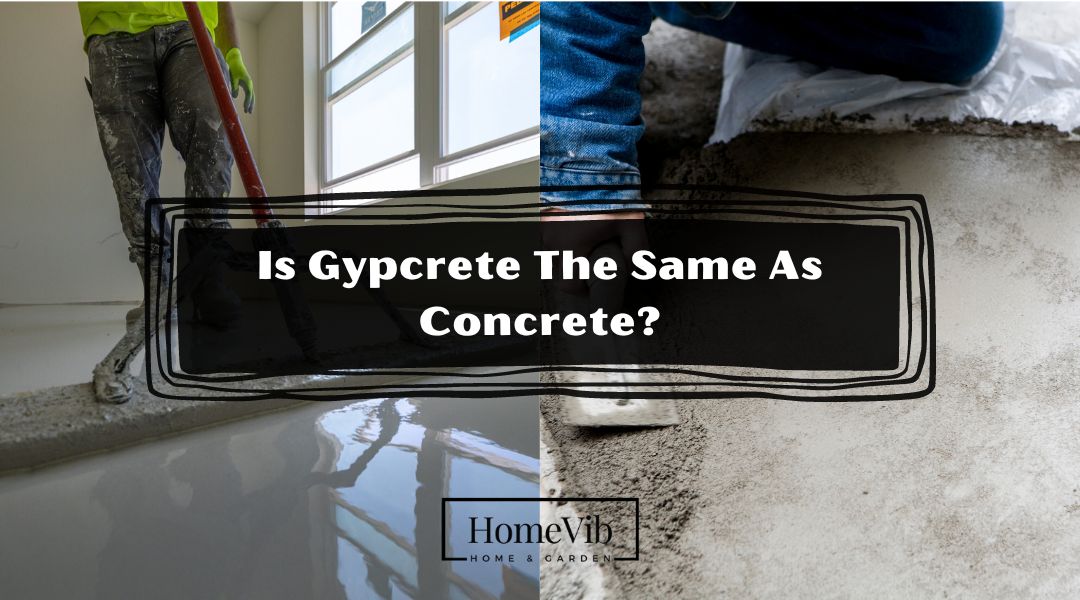
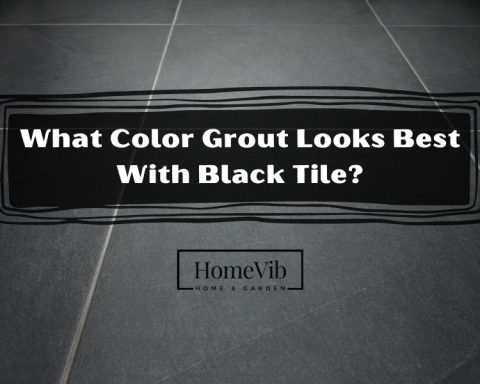
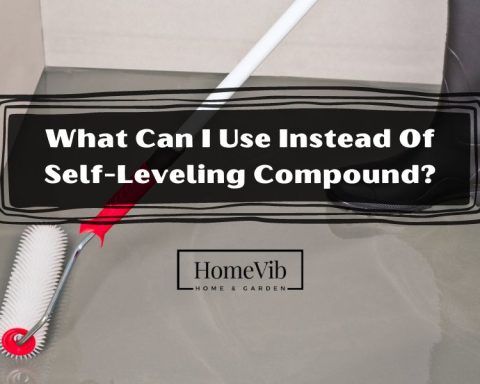
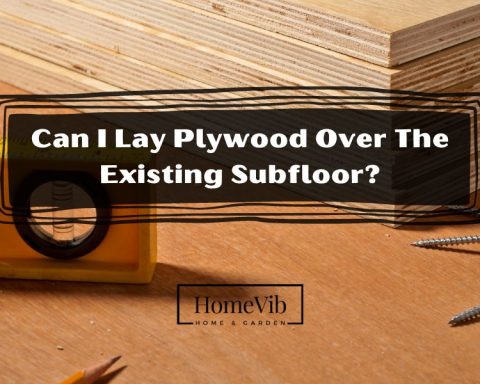





Once the gypcrete is cured, will it help if apply seal coat or epoxy for durable or will protect cracks